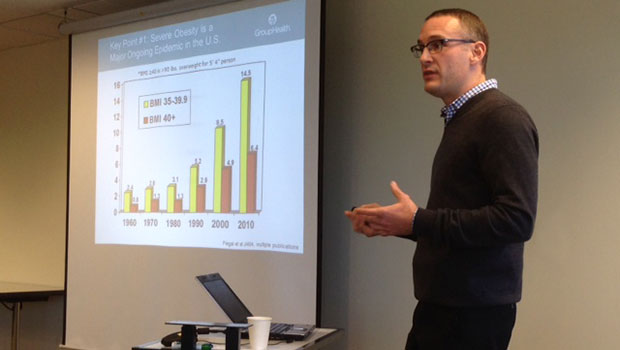Two types of bariatric surgery give similar outcomes at 5 years

But longer follow-up is needed to compare sleeve vs. bypass, says Dr. Arterburn, who wrote a JAMA editorial with Dr. Gupta
by David Arterburn, MD, MPH, a senior investigator at Kaiser Permanente Washington Health Research Institute
The landscape for bariatric (weight-loss) procedures keeps changing. A decade ago, the most popular bariatric procedure was to place an adjustable gastric band around the stomach. Since then, banding has been all but abandoned.
That’s because of longer-term research showing worse results with banding — less weight loss, less remission of diabetes, and more repeat operations — than with Roux-en-Y gastric bypass. Gastric bypass surgery involves directly connecting a small part of the stomach to the middle of the small intestine, bypassing most of the stomach and the top of the small intestine.
In the past few years, sleeve gastrectomy (surgically removing most of the stomach with a single vertical incision) has become the bariatric procedure that is most often performed. Like banding, sleeve gastrectomy is simpler to perform than bypass surgery. But because sleeve gastrectomy is so new, we’ve lacked rigorous evidence about its long-term outcomes for weight, diabetes, reoperations, and safety.
Déjà vu all over again?
Some people have wondered whether sleeve gastrectomy might be banding redux. Not so, according to new 5-year results from two randomized trials in JAMA, showing similar effects on weight and some diabetes endpoints with sleeve gastrectomy and bypass. My colleague Dr. Anirban Gupta, a bariatric surgeon at Kaiser Permanente Washington, and I wrote the accompanying editorial: “Comparing the Outcomes of Sleeve Gastrectomy and Roux-en-Y Gastric Bypass for Severe Obesity.”
While generally reassured by these 5-year results, Dr. Gupta and I note a few concerns:
- Compared to bypass, sleeve gastrectomy was followed by much more new cases of gastroesophageal reflux disorder (GERD) and worsening of existing GERD symptoms. This matters, because GERD is already present in as many has half of patients with severe obesity who seek bariatric surgery.
- Although the sleeve procedure had been thought to have a lower risk of complications than gastric bypass, reoperations were similarly common with both procedures. The differences in reoperation rates were not large enough to reach statistical significance in these studies.
- After sleeve gastrectomy, reoperations were usually for GERD; after bypass, they were usually for small bowel obstruction or internal hernias.
- It is important to minimize the risk of reoperation with both procedures: closing all hiatal hernias, no matter how small, to minimize the risk of GERD, and closing mesenteric defects to minimize the risk of internal hernias.
- Although we know that the operative risks of any second bariatric operation are higher, we don’t yet fully understand how effective reoperations are over the long haul.
We look forward to longer follow-up of 10 years — particularly from population-based studies — to better inform surgeons and severely obese patients as they weigh the complex pros and cons of the various available treatments together in shared decision making.
Learn more about Kaiser Permanente Washington Health Research Institute. Sign up for our free monthly newsletter.


